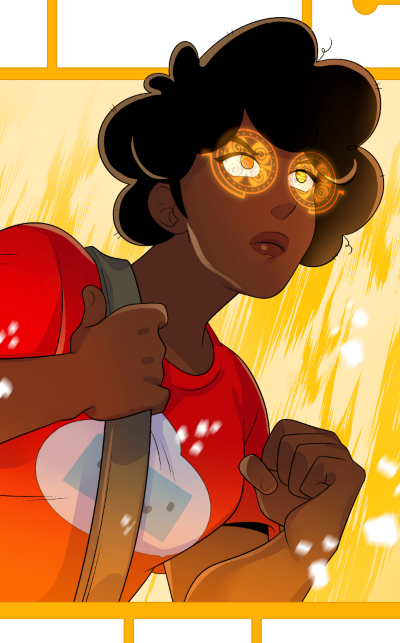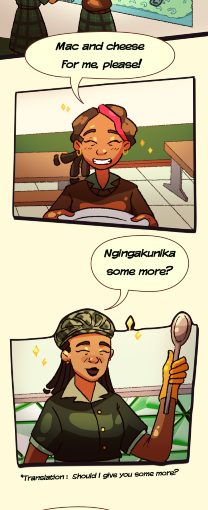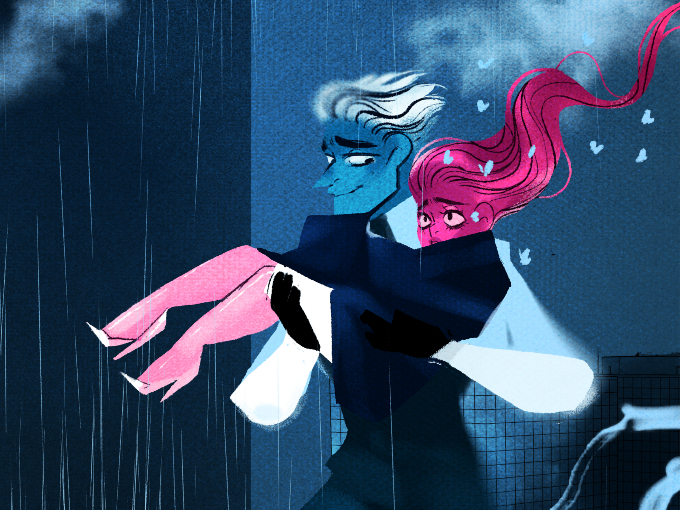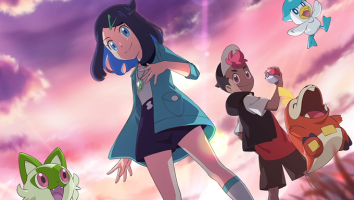A 21st-century innovation in kids storytelling is starting to attract huge audiences, big-fish brands and recognition for its ability to incubate great content.
For the uninitiated, webtoons are episodic digital comics formatted to let readers easily scroll through graphic panels on their smartphones. Since originating in South Korea in 2000, they have ballooned into a thriving global industry that’s expected to hit US$10.8 billion this year, on its way to a whopping US$31.2 billion by 2029, according to The Business Research Company.
At the heart of this market is a South Korean content platform called WEBTOON, which reached 160 million active monthly users in 150-plus countries in December. It features more than 55 million webtoon titles spanning 23 genres—900 of which have already been adapted into streamable series and films. And WEBTOON predicts that many more adaptations are on the way. Readers in North America, Korea and Japan spend an average of 30 minutes a day reading stories on WEBTOON, according to the company. And this presents a potentially lucrative IP development route for indie creators and studios, since the platform is free to join and monetized through ads and viewer purchases of “Super Likes” for individual stories, with creators getting a cut of both.
Between 2017 and 2023, WEBTOON paid a total of US$2.8 billion to content creators featured on its platform. The average webtoon creator can earn up to US$48,000 a year, with the top 100 making as much as US$1 million.

Romance webtoon Night Owls and Sumemr Skies is based on a web-first novel—one of many books that are finding new audiences as digital comics
And webtoons are drawing attention from more traditional animation producers and buyers, too—anime SVOD Crunchyroll premiered season two of its webtoon-inspired teen series Solo Leveling in January, and last year it ordered adaptations of YA-skewing titles Omniscient Reader and Dark Moon: The Blood Altar.
For producers, there are two main approaches when it comes to capitalizing on the reach and appeal of webtoons. They can launch a new IP in this format to test the waters and cultivate a following before expanding into other types of content. Or they can mine the most popular webtoon titles for adaptations and tap into their already significant fandoms. Each strategy offers some distinct advantages.
Building an audience
Johannesburg’s Cabblow Studios is currently going down the webtoon-first road with its new YA-skewing title Rorisang & The Gurlz, a mental health-focused story that revolves around a South African girl who starts a K-pop band with her friends. Cabblow released the first installment on WEBTOON in March 2023 and regularly updates the series with new episodes. To date, this webcomic has surpassed 10,000 views.
As a small South African studio, Cabblow found that TV buyers and distributors were less willing to take a chance on its IPs. So the studio had to find a cost-effective way to introduce and build an audience for them, says founder and creative director Kabelo Maaka.
There have been several side benefits to launching Rorisang & The Gurlz as a webtoon. For one, creating the art for its episodes gives the studio plenty of assets for social posts on TikTok and Instagram, including recaps and humorous videos in which Rorisang shares her interests in voice-overs paired with visuals from the webtoon. Once the studio’s followers on WEBTOON and social media started asking questions and engaging with its content, Cabblow self-financed a 22-minute 2D-animated TV series pilot, with the webtoon functioning as a storyboard and providing most of the art assets.
Working on the comic at the same time also let the team test visuals, refine character designs and get audience feedback, adjusting the pilot accordingly. For example, fans liked the webtoon visuals of thought bubbles popping up on screen and the word “transition” flashing when the scene shifts, so those elements have been added to the pilot.
The animation on Rorisang is 90% complete, and the team is now at the compositing and coloring stage. The plan is to complete the pilot in Q2, and then go looking for distributors and broadcast partners. “We had to make our property sellable, and a pitch deck just isn’t enough to stand out,” says Maaka. “This is a new way to build an animated character, and it’s uncharted territory because it’s a model we haven’t seen before.”
Going the partnership route
Taking a different approach to embracing the webtoon market, The Jim Henson Company has teamed up with Wattpad WEBTOON Studios to turn Lore Olympus (pictured at top)—the platform’s most popular title, with roughly 1.4 billion views—into a 2D-animated series for young adults. The 2018 webtoon is a modern retelling of the Greek myth about the goddess Persephone, who becomes Queen of the Underworld after she’s abducted by Hades.
Henson is prepared to go into production on the series as soon as it’s greenlit, says executive producer Halle Stanford, and the company already has a writer on board and several animation tests in the can.
With its massive audience and a darkly edgy but fun art style, Lore Olympus is an obvious choice for a screen adaptation, says Stanford. And it’s also similar in tone to one of Henson’s most popular existing IPs—Labyrinth, a fairytale romance feature film starring David Bowie, circa 1986. “The story of Greek gods [and] the retold Persephone and Hades [myth] could propel us into this primetime fantasy-romance space,” she adds.
The challenge, of course, is to turn this successful webcomic into something that works for TV. “We needed to tease out the overarching story that’s unfolding on Mount Olympus, and how Persephone and Hades are a part of it,” says Stanford. “But also, [Lore Olympus creator] Rachel Smythe’s art and design were really made for the web and scrolling, so we had an opportunity to [reimagine] the world, the backgrounds and the details.”
Wattpad WEBTOON Studios has already built a strong licensing business around the Lore Olympus IP, with deals in place for apparel, figures, postcards and physical books (volume nine will launch at Barnes & Noble in October). “I think we’re in a good position because of the success of the franchise in the webcomic space,” says Stanford. “We have really great material and two really strong companies. We love collaborating with Wattpad WEBTOON Studios. Together, we have the power to make this happen.”
France’s webtoon ambitions
Historically quick to adopt other breakout storytelling formats from the east, like anime and manga, French companies are leading the charge when it comes to building a local industry around webtoons.
There are roughly five million daily webtoon readers in France, estimates Caroline Duvochel, head of audiovisual & innovation for French media conglomerate Média-Participations. Reaching such a large local readership is compelling—and other points of appeal include the format’s ability to tell strong visual stories, its accessibility on mobile devices, and the freemium model of the platforms that distribute this content.
Média-Participations—which owns multiple publishing houses, as well as the production studio Ellipse Animation—is making a company-wide push into webtoons. Last year, it launched the first Webtoon Academy, a free training program in Angoulême that teaches French producers how to make and monetize webtoons. In partnership with Korean webtoon producer Kenaz and French webtoon platform ONO (a Média-Participations subsidiary), the program also sends selected participants to South Korea to network and further develop their IPs.
“The Academy addresses the [challenges] of getting know-how and reaching the worldwide market,” says Duvochel. “France alone is not big enough to be the right scale for webtoon production, so international scale is a must.”
It helps that webtoons have a pipeline that’s similar to animation (including bibles, storyboarding, character design, coloring, etc.) and similar terminology (webtoons have seasons and episodes, rather than chapters), making them familiar and appealing to animation producers, Duvochel adds.
At the heart of Média-Participations’ interest in webtoons is a broader desire to tap into the Korean business approach of OSMU (one source, multiple use), which perfectly sums up the company’s goals for its own IPs, says Duvochel.
“Through webtoons, we test stories and can adjust them. We create a strong audience, and then we are able to license them to create books, video games, movies and TV series. This is exciting and very complementary to what we can do in animation, which is expensive and doesn’t have the same agility.”
In addition to developing its own original animated series, Ellipse is also expanding into webtoons to provide production services for third-party content. Meanwhile, ONO is well on its way to proving that there’s strong demand for webtoons in the French market—the platform has racked up more than half a million downloads since it launched in 2023.
An untapped licensing opportunity
The merch potential of webtoons has been quietly developing over the past few years, and the licensing industry is now primed to start delivering consumer products based on these titles at scale, says Elan Freedman, SVP of business development at Surge Licensing, an agent for WEBTOON. The key to a successful licensing business is finding IPs with audience-building capability, and webtoons have plenty of that, he adds.

Team Weird Enough’s The UnCommons is a fantasy/superhero story that follows a group of kids trying to save the world from ending
In 2023, Surge and Genuine Entertainment signed WEBTOON’s first-ever US licensing deals for popular titles including Lore Olympus and Tower of God, with companies such as Bioworld (backpacks/apparel), Walter Foster Publishing (instructional art and craft books and kits) and FiGPiN (collectible pins) among the first wave of partners.
And these days, Freedman says licensees and retailers alike see the potential of webtoon fan communities as markets for significant consumer products pushes.
For both groups, the ultimate appeal of webtoons is that creators can tap into their direct audience relationships to tell fans about new products and encourage them to buy. Plus, there’s plenty of webtoon audience data available, which takes the guesswork out of product planning and purchasing decisions.
For its part, WEBTOON opened its own e-commerce hub called WEBTOON Shop in late 2024, hiring former Spin Master licensing director Shane Mang to run it as head of licensing & merchandising.
BOOKING IT: Random House jumps on the webtoons bandwagon
Random House Graphic (an imprint of Random House Children’s Books) is starting its own chapter in the webtoon market this year with Ink Pop—a new line that includes print editions of webtoons aimed at kids and teens, as well as translated graphic novels.
Ink Pop will bring popular international titles to the US, in English and book form for the first time, says Random House Graphic executive editor Whitney Leopard. First up on July 1 is an English-language printing of YA webtoon-turned-manga series I Wanna Be Your Girl, followed closely by YA romance My Life As An Internet Novel on September 2.
But the publisher has also identified an underserved kids market for webtoons (which tend to be dominated by YA titles), and plans to fill it with middle-grade and chapter books touching on genres such as fantasy, mystery and humor. Random House is gearing up to announce its first kids titles later this year, and it’s also in discussions with other potential partners, says Leopard.
“Every studio and publisher we’ve talked to has been excited about putting their foot in the door of the US [webtoon] market,” she says. “I’m also excited to bring webtoons into the children’s space as a recognized story format that can be entered for awards and recognized as an art form.”
BEHIND THE BUILD: The making of Rorisang & The Gurlz
Because webtoons don’t require animation or printing, they’re a lot cheaper to produce and release than other content formats. But companies need to treat them as a long-term investment and have a plan for taking them to market that will deliver results consistently, says Kabelo Maaka, founder of Cabblow Studios.

It costs the Johannesburg-based studio US$7,000 to US$9,000 a month to produce 1.5 to three episodes. Typically, webtoon creators work as solo artists or in small teams, whereas Cabblow has eight of its 12 team members assigned to Rorisang & The Gurlz—the story of a South African girl who starts a K-pop band with her friends.
The studio waited until it had three or four episodes fully illustrated before launching the title, says Maaka. And while it took two months to complete the first 23-page installment, the team can now deliver an episode in three to four weeks, depending on scene complexity.
The webtoon audience is so hungry for new episodes that Cabblow is aiming to eventually post new ones weekly (this is the typical frequency of original webtoons). The company currently has a monthly release schedule, but publishes two or three episodes at a time to keep Rorisang’s readers satisfied until the next batch launches.
This hard work has been paying off, says Maaka. Rorisang now has roughly 2,000 subscribers and around 10,000 views on WEBTOON. Its social media presence has also grown, generating more than 30,000 views on TikTok and Instagram in March.
In terms of expansion into other types of entertainment, Cabblow is currently developing episodes two and three of an animated series based on the webtoon. And it took a live experience called Rorisang’s ColourToon Café to Comic Con Africa and the Menlyn Park Shopping Centre in Pretoria late last year. The walls and floor of this travelling booth are completely filled with line drawings from the webtoon that kids can color in.
This story originally appeared in Kidscreen‘s Q2 2025 magazine issue.























